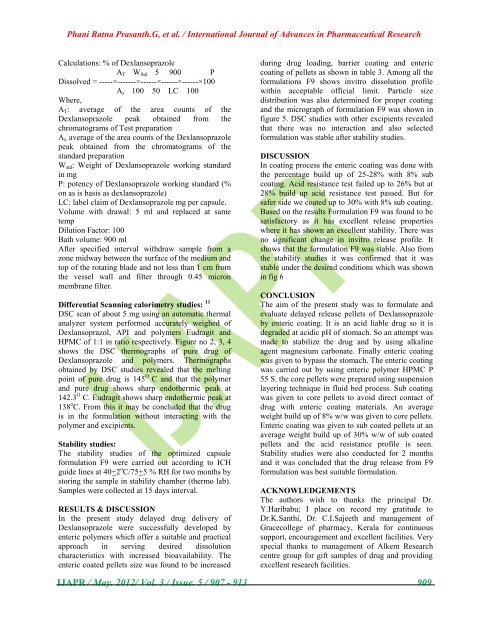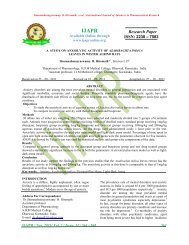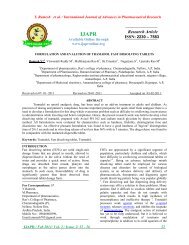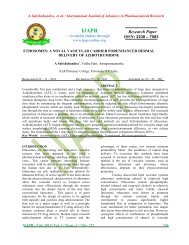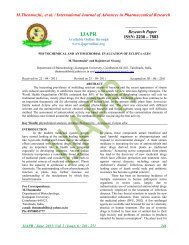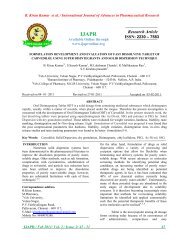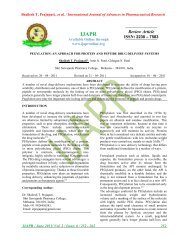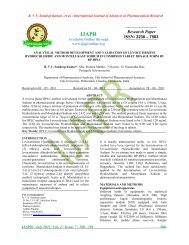international journal of advances in pharmaceutical research
international journal of advances in pharmaceutical research
international journal of advances in pharmaceutical research
Create successful ePaper yourself
Turn your PDF publications into a flip-book with our unique Google optimized e-Paper software.
Phani Ratna Prasanth.G, et al. / International Journal <strong>of</strong> Advances <strong>in</strong> Pharmaceutical Research<br />
Calculations: % <strong>of</strong> Dexlansoprazole<br />
A T W Std 5 900 P<br />
Dissolved = -----×-------×------×------×------×100<br />
A s 100 50 LC 100<br />
Where,<br />
A T : average <strong>of</strong> the area counts <strong>of</strong> the<br />
Dexlansoprazole peak obta<strong>in</strong>ed from the<br />
chromatograms <strong>of</strong> Test preparation<br />
A s: average <strong>of</strong> the area counts <strong>of</strong> the Dexlansoprazole<br />
peak obta<strong>in</strong>ed from the chromatograms <strong>of</strong> the<br />
standard preparation<br />
W std : Weight <strong>of</strong> Dexlansoprazole work<strong>in</strong>g standard<br />
<strong>in</strong> mg<br />
P: potency <strong>of</strong> Dexlansoprazole work<strong>in</strong>g standard (%<br />
on as is basis as dexlansoprazole)<br />
LC: label claim <strong>of</strong> Dexlansoprazole mg per capsule.<br />
Volume with drawal: 5 ml and replaced at same<br />
temp<br />
Dilution Factor: 100<br />
Bath volume: 900 ml<br />
After specified <strong>in</strong>terval withdraw sample from a<br />
zone midway between the surface <strong>of</strong> the medium and<br />
top <strong>of</strong> the rotat<strong>in</strong>g blade and not less than 1 cm from<br />
the vessel wall and filter through 0.45 micron<br />
membrane filter.<br />
Differential Scann<strong>in</strong>g calorimetry studies: 11<br />
DSC scan <strong>of</strong> about 5 mg us<strong>in</strong>g an automatic thermal<br />
analyzer system performed accurately weighed <strong>of</strong><br />
Dexlansoprazol, API and polymers Eudragit and<br />
HPMC <strong>of</strong> 1:1 <strong>in</strong> ratio respectively. Figure no 2, 3, 4<br />
shows the DSC thermographs <strong>of</strong> pure drug <strong>of</strong><br />
Dexlansoprazole and polymers. Thermographs<br />
obta<strong>in</strong>ed by DSC studies revealed that the melt<strong>in</strong>g<br />
po<strong>in</strong>t <strong>of</strong> pure drug is 145 O C and that the polymer<br />
and pure drug shows sharp endothermic peak at<br />
142.3 O C. Eudragit shows sharp endothermic peak at<br />
138 o C. From this it may be concluded that the drug<br />
is <strong>in</strong> the formulation without <strong>in</strong>teract<strong>in</strong>g with the<br />
polymer and excipients.<br />
Stability studies:<br />
The stability studies <strong>of</strong> the optimized capsule<br />
formulation F9 were carried out accord<strong>in</strong>g to ICH<br />
guide l<strong>in</strong>es at 40+2 o C/75+5 % RH for two months by<br />
stor<strong>in</strong>g the sample <strong>in</strong> stability chamber (thermo lab).<br />
Samples were collected at 15 days <strong>in</strong>terval.<br />
RESULTS & DISCUSSION<br />
In the present study delayed drug delivery <strong>of</strong><br />
Dexlansoprazole were successfully developed by<br />
enteric polymers which <strong>of</strong>fer a suitable and practical<br />
approach <strong>in</strong> serv<strong>in</strong>g desired dissolution<br />
characteristics with <strong>in</strong>creased bioavailability. The<br />
enteric coated pellets size was found to be <strong>in</strong>creased<br />
dur<strong>in</strong>g drug load<strong>in</strong>g, barrier coat<strong>in</strong>g and enteric<br />
coat<strong>in</strong>g <strong>of</strong> pellets as shown <strong>in</strong> table 3. Among all the<br />
formulations F9 shows <strong>in</strong>vitro dissolution pr<strong>of</strong>ile<br />
with<strong>in</strong> acceptable <strong>of</strong>ficial limit. Particle size<br />
distribution was also determ<strong>in</strong>ed for proper coat<strong>in</strong>g<br />
and the micrograph <strong>of</strong> formulation F9 was shown <strong>in</strong><br />
figure 5. DSC studies with other excipients revealed<br />
that there was no <strong>in</strong>teraction and also selected<br />
formulation was stable after stability studies.<br />
DISCUSSION<br />
In coat<strong>in</strong>g process the enteric coat<strong>in</strong>g was done with<br />
the percentage build up <strong>of</strong> 25-28% with 8% sub<br />
coat<strong>in</strong>g. Acid resistance test failed up to 26% but at<br />
28% build up acid resistance test passed. But for<br />
safer side we coated up to 30% with 8% sub coat<strong>in</strong>g.<br />
Based on the results Formulation F9 was found to be<br />
satisfactory as it has excellent release properties<br />
where it has shown an excellent stability. There was<br />
no significant change <strong>in</strong> <strong>in</strong>vitro release pr<strong>of</strong>ile. It<br />
shows that the formulation F9 was stable. Also from<br />
the stability studies it was confirmed that it was<br />
stable under the desired conditions which was shown<br />
<strong>in</strong> fig 6<br />
CONCLUSION<br />
The aim <strong>of</strong> the present study was to formulate and<br />
evaluate delayed release pellets <strong>of</strong> Dexlansoprazole<br />
by enteric coat<strong>in</strong>g. It is an acid liable drug so it is<br />
degraded at acidic pH <strong>of</strong> stomach. So an attempt was<br />
made to stabilize the drug and by us<strong>in</strong>g alkal<strong>in</strong>e<br />
agent magnesium carbonate. F<strong>in</strong>ally enteric coat<strong>in</strong>g<br />
was given to bypass the stomach. The enteric coat<strong>in</strong>g<br />
was carried out by us<strong>in</strong>g enteric polymer HPMC P<br />
55 S. the core pellets were prepared us<strong>in</strong>g suspension<br />
layer<strong>in</strong>g technique <strong>in</strong> fluid bed process. Sub coat<strong>in</strong>g<br />
was given to core pellets to avoid direct contact <strong>of</strong><br />
drug with enteric coat<strong>in</strong>g materials. An average<br />
weight build up <strong>of</strong> 8% w/w was given to core pellets.<br />
Enteric coat<strong>in</strong>g was given to sub coated pellets at an<br />
average weight build up <strong>of</strong> 30% w/w <strong>of</strong> sub coated<br />
pellets and the acid resistance pr<strong>of</strong>ile is seen.<br />
Stability studies were also conducted for 2 months<br />
and it was concluded that the drug release from F9<br />
formulation was best suitable formulation.<br />
ACKNOWLEDGEMENTS<br />
The authors wish to thanks the pr<strong>in</strong>cipal Dr.<br />
Y.Haribabu; I place on record my gratitude to<br />
Dr.K.Santhi, Dr. C.I.Sajeeth and management <strong>of</strong><br />
Gracecollege <strong>of</strong> pharmacy, Kerala for cont<strong>in</strong>uous<br />
support, encouragement and excellent facilities. Very<br />
special thanks to management <strong>of</strong> Alkem Research<br />
centre group for gift samples <strong>of</strong> drug and provid<strong>in</strong>g<br />
excellent <strong>research</strong> facilities.<br />
IJAPR / May. 2012/ Vol. 3 / Issue. 5 / 907 - 913 909


